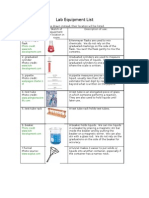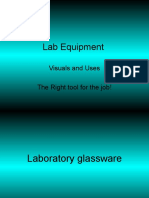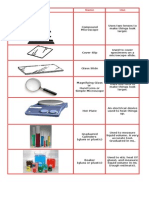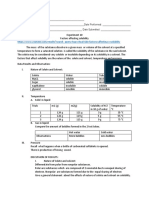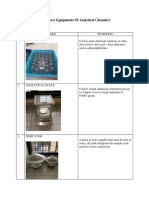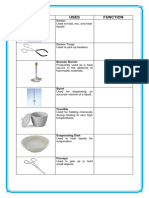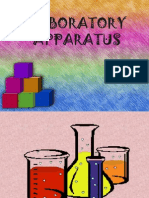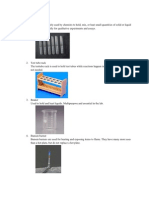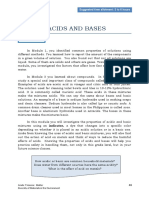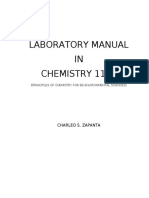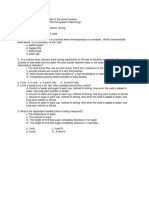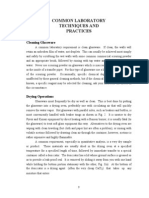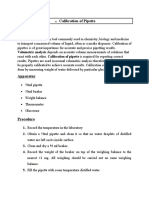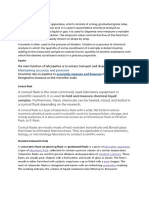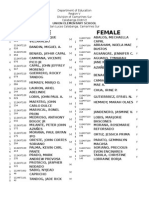Professional Documents
Culture Documents
Common Laboratory Apparatus
Uploaded by
Domingo F. Combate Jr.Copyright
Available Formats
Share this document
Did you find this document useful?
Is this content inappropriate?
Report this DocumentCopyright:
Available Formats
Common Laboratory Apparatus
Uploaded by
Domingo F. Combate Jr.Copyright:
Available Formats
Common Laboratory Apparatus
1.Test Tube 2.Test Tube Rack
Test Tube Holder
Reagent Bottle
Beaker
Bunsen Burner
Stand and Clamp
Crucible
Measuring Cylinder
Dropper
Electronic Balance
Evaporating Dish
Filter Funnel
Flat Bottomed Flask
Safety Glasses
Mortar and Pestle (used for grinding paste or powder)
Round Bottomed Flask
Spatula
Tripod
Plastic Wash Bottle
Wire Gauze
Triple Beam Balance
1. Bunsen Burner
o
A Bunsen burner provides concentrated and adjustable heat for experiments. A tube connects the burner to the laboratory gas supply. When the Bunsen burner is lit, the flame can be adjusted using the air hole. Closing the air hole produces an easily visible, luminous flame is produced that is not good for heating. It should be opened when the Bunsen burner is used to heat chemicals.
Beaker
o
A beaker is a cylindrical glass or plastic vessel used for holding liquids. It is a multi-purpose piece of equipment used for containing a chemical reaction, measuring liquids, heating them over a Bunsen burner's flame or collecting them in a titration experiment.
Graduated Cylinder
o
A graduated cylinder is a relatively slim glass or plastic cylinder used specifically for calibrating beakers or measuring a liquid's volume. Graduated cylinders come in a variety of sizes such as 10 ml, 25 ml, 50 ml, 100 ml, 500 ml and 1,000 ml. Scientists take measuremens by viewing, at eye-level, the lowest point of the convex dip that the liquid in the cylinder makes.
Test Tube
o
A test tube is a relatively slim glass or plastic vessel with a rounded bottom. They are designed to hold small quantities of chemicals and feature a flared lip to make pouring easier. Test tubes can hold liquid or solid chemicals and can be used to contain small chemical reactions. The slimness of the test tube reduces the spread of any vapors that may be produced by the reaction.
Evaporating Dish
An evaporating dish is a glazed porcelain vessel used to heat and consequently evaporate liquids. In this way experiments can increase a liquid's concentration. The dish is relatively shallow and features a lip to facilitate pouring the liquids.
Pipet
o
A pipet transfers relatively small amounts of liquid. In the most commonly used pipettes, experimenters draw liquid into one end of a glass or plastic cylinder by the prior squeezing of the rubber or plastic ball at the opposite end. The amount of liquid able to be drawn into the pipette is usually fixed, to enable accuracy in measurement.
A crucible is a container that can withstand very high temperatures and is used for metal, glass, and pigment production as well as a number of modern laboratory processes.
You might also like
- Laboratory ApparatusDocument5 pagesLaboratory ApparatusYong Leong Chai75% (4)
- Lab Equipment PowerpointDocument43 pagesLab Equipment Powerpointangelo tonogbanua100% (1)
- Laboratory Equipment and Their FunctionsDocument42 pagesLaboratory Equipment and Their FunctionsAtika RachmasariNo ratings yet
- Lab Equipment List: Photo Credit: WWW - KohDocument6 pagesLab Equipment List: Photo Credit: WWW - Kohsidthornton92% (12)
- Laboratory Apparatuses and UsesDocument2 pagesLaboratory Apparatuses and UsesDanielle Elish Goco88% (33)
- Lab Equipment Powerpoint 1Document50 pagesLab Equipment Powerpoint 1Dylan Brhyce Esparagoza100% (1)
- Chemistry ApparDocument26 pagesChemistry ApparShihabsir100% (1)
- Common Laboratory EquipmentDocument4 pagesCommon Laboratory EquipmentMG Untalan BauzonNo ratings yet
- Laboratory Equipments and Their UsesDocument3 pagesLaboratory Equipments and Their UsesMaria Teresa Gimeno100% (4)
- Laboratory ToolsDocument4 pagesLaboratory ToolsRosel Gonzalo-Aquino100% (3)
- Experiment 10. Factors Affecting SolubilityDocument2 pagesExperiment 10. Factors Affecting SolubilityHanna Gwyneth DollanoNo ratings yet
- Laboratory Equipments of Analytical ChemistryDocument2 pagesLaboratory Equipments of Analytical ChemistryFiryal Nabilah Q ANo ratings yet
- Activity 1 Common Laboratory Apparatus: ObjectivesDocument11 pagesActivity 1 Common Laboratory Apparatus: ObjectivesChristian Arby BantanNo ratings yet
- Laboratory ApparatusDocument37 pagesLaboratory Apparatusalancstnd67% (3)
- Common Laboratory ToolsDocument4 pagesCommon Laboratory ToolsMargie Ballesteros Manzano0% (1)
- Laboratory ApparatusDocument35 pagesLaboratory ApparatusDëv Pacificar100% (2)
- Pictures of Chemistry Laboratory Apparatus Their UsesDocument5 pagesPictures of Chemistry Laboratory Apparatus Their UsesEvangeline Mendoza Michael100% (8)
- Experiment No. 3 Elements, Compounds, MixturesDocument4 pagesExperiment No. 3 Elements, Compounds, MixturesHans Bugarin100% (1)
- Chemistry Laboratory Apparatus and Their UsesDocument4 pagesChemistry Laboratory Apparatus and Their Usesdexter leodin100% (1)
- Lab ApparatusDocument6 pagesLab ApparatusRandolf AsiaNo ratings yet
- 05 - Naphtalene, Salt & SandDocument1 page05 - Naphtalene, Salt & SandShayan MujtabaNo ratings yet
- Laboratory ApparatusDocument44 pagesLaboratory ApparatusJerneth Nyka FloresNo ratings yet
- Science Quiz Bee Questions (Chemistry)Document1 pageScience Quiz Bee Questions (Chemistry)Anthony Gio L. Andaya100% (1)
- Sublimation and RecrystallizationDocument6 pagesSublimation and RecrystallizationDinah Jane Martinez100% (1)
- Ecological Relationship QuizDocument1 pageEcological Relationship QuizMariz RaymundoNo ratings yet
- Experiment No. 4 Common Laboratory Operations and Separation TechniquesDocument6 pagesExperiment No. 4 Common Laboratory Operations and Separation TechniquesGiuliani AbadillaNo ratings yet
- Newtons Laws Matching ActivityDocument4 pagesNewtons Laws Matching ActivityHasmin Cueto0% (1)
- Eggplant PH Indicator PDFDocument15 pagesEggplant PH Indicator PDFGlen MillarNo ratings yet
- Quiz About SolutionsDocument4 pagesQuiz About Solutionsmay ann dimaanoNo ratings yet
- 40 Common Laboratory ApparatusesDocument23 pages40 Common Laboratory ApparatusesDwen Taylan Manacop100% (1)
- Common Laboratory ApparatusDocument2 pagesCommon Laboratory ApparatusFaye TancincoNo ratings yet
- Principles of Volumetric AnalysisDocument45 pagesPrinciples of Volumetric AnalysisMrl AshiaNo ratings yet
- Properties of SolutionsDocument33 pagesProperties of SolutionsJohn Barry Ibanez100% (2)
- 20 Common Laboratory ApparatusDocument11 pages20 Common Laboratory ApparatusJINGKY HUMAMOY100% (1)
- Plugging and Wrapping of Glassware For SterilizationDocument4 pagesPlugging and Wrapping of Glassware For SterilizationHoe0% (1)
- Lab Safety QuizDocument6 pagesLab Safety QuizlorenckleinNo ratings yet
- General-Chemistry LM8Document8 pagesGeneral-Chemistry LM8ShipsGonnaSailNo ratings yet
- #3 SolutionDocument4 pages#3 SolutionTracy Blair100% (2)
- Lab Equipment and UsesDocument2 pagesLab Equipment and UsesReka FuentesNo ratings yet
- Making A Hay InfusionDocument1 pageMaking A Hay InfusionJohn OsborneNo ratings yet
- Ed. LABORATORY-MANUAL-CHEM-1108Document74 pagesEd. LABORATORY-MANUAL-CHEM-1108Joevelyn ValdezNo ratings yet
- Bio - Wax From Colocasia Esculenta As Water Repellent in Road ConstructionDocument34 pagesBio - Wax From Colocasia Esculenta As Water Repellent in Road ConstructionJOFIN JO RAJI100% (1)
- Gram StainDocument2 pagesGram StainAltea ArayataNo ratings yet
- Exemplar Science Lesson Plan For Senior High School General Biology 1Document3 pagesExemplar Science Lesson Plan For Senior High School General Biology 1Arnel Metillo0% (1)
- Multiple Choice Quiz Science 7Document3 pagesMultiple Choice Quiz Science 7MARCELINO REYESNo ratings yet
- Lab 5 CHM130LL Paper Chromatography W Answer Key PDFDocument5 pagesLab 5 CHM130LL Paper Chromatography W Answer Key PDFClemo 20% (1)
- Common Laboratory OperationsDocument20 pagesCommon Laboratory OperationsJose Barrera Galera0% (1)
- Tos-General Chemistry Summative TosDocument2 pagesTos-General Chemistry Summative TosChona Calvelo100% (1)
- Determination of Molecular Weight Through Boiling Point ElevationDocument1 pageDetermination of Molecular Weight Through Boiling Point ElevationremNo ratings yet
- Commonly Encountered Equipment in The Chemistry LaboratoryDocument9 pagesCommonly Encountered Equipment in The Chemistry Laboratorysadiqah mushtaqNo ratings yet
- Lab 1 Culture Microorganism by Hay Infusion - forBSEd III-P PDFDocument2 pagesLab 1 Culture Microorganism by Hay Infusion - forBSEd III-P PDFKarl Francis GarciaNo ratings yet
- Multiple-Choice Test Chapter 8: Transport in Plants: 1 A B C D 2 A B C D 3 A B C D 4 A B C D 5 A B C DDocument2 pagesMultiple-Choice Test Chapter 8: Transport in Plants: 1 A B C D 2 A B C D 3 A B C D 4 A B C D 5 A B C DsybejoboNo ratings yet
- Experiment 1:: Difference Between Organic and Inorganic CompoundsDocument18 pagesExperiment 1:: Difference Between Organic and Inorganic CompoundsJared PomarejosNo ratings yet
- Experiment 3 Sublimation and Melting PointDocument3 pagesExperiment 3 Sublimation and Melting PointJuan CarlosNo ratings yet
- DLP in Demo Chem 1Document4 pagesDLP in Demo Chem 1Jeffrey YumangNo ratings yet
- Particulate Nature of MatterDocument5 pagesParticulate Nature of MatterLe Maurice CiminiNo ratings yet
- Calibration of PipetteDocument4 pagesCalibration of PipetteMg H100% (1)
- Maintaining Accuracy and PrecisionDocument6 pagesMaintaining Accuracy and PrecisionAkshit ParmarNo ratings yet
- Know Your Lab Equipments: Test TubeDocument9 pagesKnow Your Lab Equipments: Test TubeWelly Boss HwiNo ratings yet
- Chemistry Laboratory: Group 1Document51 pagesChemistry Laboratory: Group 1Rachel Ann De LeonNo ratings yet
- 1st Quarter Assessment Checklist: Grade and Section: III-YakalDocument2 pages1st Quarter Assessment Checklist: Grade and Section: III-YakalDomingo F. Combate Jr.No ratings yet
- We Give Our Yes - Jamie RiveraDocument1 pageWe Give Our Yes - Jamie RiveraDomingo F. Combate Jr.No ratings yet
- Sworn Statement of Assets, Liabilities and Net Worth (Saln) : Combate Aida TDocument4 pagesSworn Statement of Assets, Liabilities and Net Worth (Saln) : Combate Aida TDomingo F. Combate Jr.No ratings yet
- 2019 Medical 3rd CongressDocument14 pages2019 Medical 3rd CongressDomingo F. Combate Jr.No ratings yet
- English Science: Grade Four ProgramDocument6 pagesEnglish Science: Grade Four ProgramDomingo F. Combate Jr.No ratings yet
- 2016 Awit Ki San PeregrinoDocument3 pages2016 Awit Ki San PeregrinoDomingo F. Combate Jr.100% (1)
- Male Female: Union Elementary SchoolDocument2 pagesMale Female: Union Elementary SchoolDomingo F. Combate Jr.No ratings yet
- Carpentry Grade 8 Week 1 2Document20 pagesCarpentry Grade 8 Week 1 2SANTIAGO ALVISNo ratings yet
- Module 2 TechnologyDocument20 pagesModule 2 Technologybenitez1No ratings yet
- Universal and Commercial Banks in The PhilippinesDocument1 pageUniversal and Commercial Banks in The Philippinesjohngo888No ratings yet
- Jurnal Vol. IV No.1 JANUARI 2013 - SupanjiDocument11 pagesJurnal Vol. IV No.1 JANUARI 2013 - SupanjiIchsan SetiadiNo ratings yet
- Watch One Piece English SubDub Online Free On Zoro - ToDocument1 pageWatch One Piece English SubDub Online Free On Zoro - ToSadeusuNo ratings yet
- Furnace Temperature & PCE ConesDocument3 pagesFurnace Temperature & PCE ConesAbdullrahman Alzahrani100% (1)
- India Biotech Handbook 2023Document52 pagesIndia Biotech Handbook 2023yaduraj TambeNo ratings yet
- ProjectDocument33 pagesProjectPiyush PatelNo ratings yet
- Scrum Handbook: Scrum Training Institute PressDocument66 pagesScrum Handbook: Scrum Training Institute PressFranky RiveroNo ratings yet
- Dept & Sem: Subject Name: Course Code: Unit: Prepared byDocument75 pagesDept & Sem: Subject Name: Course Code: Unit: Prepared by474 likithkumarreddy1No ratings yet
- Tourbier Renewal NoticeDocument5 pagesTourbier Renewal NoticeCristina Marie DongalloNo ratings yet
- FKTDocument32 pagesFKTNeeraj SharmaNo ratings yet
- DevOps Reference CardDocument2 pagesDevOps Reference CardIntizarchauhanNo ratings yet
- Vishal: Advanced Semiconductor Lab King Abdullah University of Science and Technology (KAUST) Thuwal, Saudi Arabia 23955Document6 pagesVishal: Advanced Semiconductor Lab King Abdullah University of Science and Technology (KAUST) Thuwal, Saudi Arabia 23955jose taboadaNo ratings yet
- Weg CFW500 Enc PDFDocument32 pagesWeg CFW500 Enc PDFFabio Pedroso de Morais100% (1)
- VLT 6000 HVAC Introduction To HVAC: MG.60.C7.02 - VLT Is A Registered Danfoss TrademarkDocument27 pagesVLT 6000 HVAC Introduction To HVAC: MG.60.C7.02 - VLT Is A Registered Danfoss TrademarkSamir SabicNo ratings yet
- Coco Mavdi Esl5Document6 pagesCoco Mavdi Esl5gaurav222980No ratings yet
- JBF Winter2010-CPFR IssueDocument52 pagesJBF Winter2010-CPFR IssueakashkrsnaNo ratings yet
- The History of Music in Portugal - Owen ReesDocument4 pagesThe History of Music in Portugal - Owen ReeseugenioamorimNo ratings yet
- Aspek Perpajakan Dalam Transfer Pricing: Related PapersDocument15 pagesAspek Perpajakan Dalam Transfer Pricing: Related PapersHasrawati AzisNo ratings yet
- Helipal Tbs Powercube ManualDocument29 pagesHelipal Tbs Powercube Manualoualid zouggarNo ratings yet
- Pontevedra 1 Ok Action PlanDocument5 pagesPontevedra 1 Ok Action PlanGemma Carnecer Mongcal50% (2)
- Managemant PrincipleDocument11 pagesManagemant PrincipleEthan ChorNo ratings yet
- The Beauty of Laplace's Equation, Mathematical Key To Everything - WIRED PDFDocument9 pagesThe Beauty of Laplace's Equation, Mathematical Key To Everything - WIRED PDFYan XiongNo ratings yet
- Process Description of Function For Every Unit OperationDocument3 pagesProcess Description of Function For Every Unit OperationMauliduni M. AuniNo ratings yet
- P66 M10 CAT B Forms and Docs 04 10Document68 pagesP66 M10 CAT B Forms and Docs 04 10VinayNo ratings yet
- Introduction To AmplifierDocument8 pagesIntroduction To AmplifierElaine BicolNo ratings yet
- SRS Document Battle Royale Origins - V2Document36 pagesSRS Document Battle Royale Origins - V2Talha SajjadNo ratings yet
- 1st Problem Solving Assignment - Barrels of Apples - M383 Sp22.docx-2Document4 pages1st Problem Solving Assignment - Barrels of Apples - M383 Sp22.docx-2Kor16No ratings yet
- ProbDocument10 pagesProbKashif JawaidNo ratings yet



